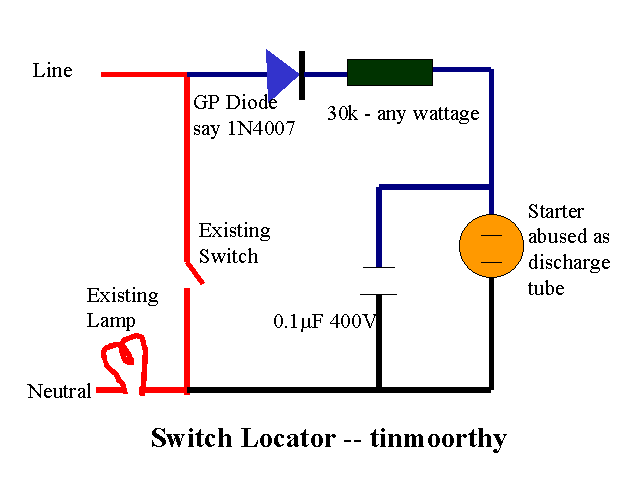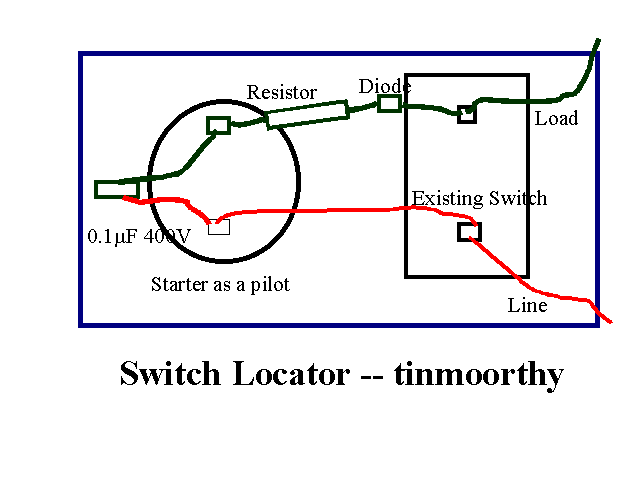
switch_locator
Hooking Up a switch locator
tinmoorthy
I am not going to tell you of something because you need it. On the contrary. Because these are available, I shall suggest -- you may have this. You ask if a shop carries namak. I am the shop keeper and tell you I have dal -- is that okay?
When you enter a dark room the first thing you look for is the switch. Let us install a neon light so the switch location can be identified in the darkness. Switch location by neon lights is an ancient technology. It has not deserved a discussion anywhere
The issue here is you want to buy a neon bulb and may be some resistors. Can you go to the corner shop and ask for these things? Even if you go to the specialized markets like the ones at Lajpatrai, Lamington Road, Ritchie or Madan Street -- formal specs will be foreign. They have never heard, because the items have never moved through them -- there are a few vendors who sell them to real professionals -- obviously you never heard of them -- that is the conundrum
Well I am going to tell you the neon tube is available inside a common tube light starter. It is not the ideal one, naturally. Sort of -- can be made use of. It is an abnormal discharge tube because it has a bi-metallic strip that gets short-circuited when enough current passes through it. There lies the catch. We shall not allow enough current. So it will be disabled from functioning as a starter. Still we shall be deploying the starter as a gas discharge tube!
The starter has other advantages too. First the housing is made transparent now-a-days. That means you get to see the glow of the discharge tube. Second, since it is a mass manufactured item it is inexpensive -- costs only five rupees at the time of this writing. It is so common that you may find it in any market. That is the message from these papers -- how to add value to such OEM common place products
I must also admit the light it is throwing out is neither bright nor can be made very bright. This is due to the compromises we began with
There is a capacitor wired in parallel to the starter tube. It can be left to stay there without any ill effect. It is originally meant as TV suppressor -- so that the TV picture will not roll during the switching activities of the starter. The starter is used with a holder that can at best be described as remotely workable. The holder will be found in any tube light. However the starter has reasonably good brass terminals on the top on which connecting wires can be jumpered. It may not be very exciting but it is just as workable as the holder we started with
The resistors form the essential masala to garnish an electronic dish. You have to locate a convenient source if you intend to peruse electronics as a hobby. All the markets named earlier have shops that sell resistors, capacitors, diodes and other sundry items. However I recommend you readily maintain a general but a restricted inventory so you may not have to run to a shop every time you want to try a new trick. These shops are in downtown -- sometimes many kilo-meters away. It is worth saving that trip downtown
Common resistors have ten percent tolerance -- unless otherwise specified. Therefore the designs have to tolerate this anomaly. Many of the designs would not thus be offended by a corresponding standard deviation of the resistor values. You may collect an assortment of resistors and say capacitors that might normally be found adequate to cover a majority of situations. Special occasions however will force a visit to the shops. Typically I am comfortable with 1k, 10k and 47k resistors. Don't ask me why. I make my life easier with a small inventory. Similarly with capacitors. You should have certainly some electrolytic capacitors because they address some specific needs. You should also have some general purpose diodes. Typically to hook up some battery eliminators, free wheeling or clamping applications. Plenty of LEDs will be handy. Particularly for wiring the pilots. A few IC sockets together with some GP ICs -- like say 555, 741, power regulators on the analog side and 7400, 7474 on the digital terrain. You are also likely to collect specific items particular to your field of specialization
The following is a schema of a relaxation oscillator. I know it may mean nothing to you. I am just throwing about some names to impress like the Jyotish who talks about the planets, their current locations while occupying your houses and hence their individual influences

The element is supposed to function as follows. The whole element is wired across the switch itself. It may appear as though the circuit is completed for the load -- but the current will be far too insufficient because of the high impedance of the switch locator we have lately inducted. Nonetheless the switch locator itself will get sufficient drive to light itself. Note however if the load is absent there will be no drive for the switch locator and therefore it is disabled to function. That I consider as fair -- if there is no bulb, there can be no light and it is then okay if you can not further locate the switch itself. If you now add a bulb, the switch locator comes alive, it starts the flicker thereby telling the world that the hook up seems functionally sane
The meager current determined by the resistor essentially (because the impedance of the load will be too small as to be ignored) and through the diode charges the capacitor. The capacitor will get charged slowly because the resistor will not permit a fast rise. The time to get charged can be manipulated choosing the appropriate R and C. After some time the capacitor may be charged to about say 90 volts -- when the neon will discharge demonstrating a visual activity. The discharge through the gas will also cause the charge to disappear gradually across the capacitor. Soon, say, reaching 60 volts the discharge unable to sustain itself will extinguish. The discharge forced on the capacitor is now removed and it begins to charge again. After some time reaching say 90 volts again, the tube discharges. The outburst causes the potential across the capacitor to drop. When it reaches say 60 volts the discharge stops. The charging process recommences. Thus the charge-discharge is repeated. You see a flicker of the neon. The rate is solely determined by the R and the C. The currents are too small normally to cause a drive of the load or the shorting of the bi-metallic strip inside the starter tube. So it can continue indefinitely through day, night, light and darkness.
When you enter the room, you will be able to locate the switch because of the flicker. The first thing you will do will be to switch the light on. This cause a short circuit across the switch locator. Therefore it is extinguished. It will come back once again when the switch is made off
The purpose of a diode and a capacitor is only to cause the relaxed oscillation. If you do not need the same you eliminate the capacitor and the diode -- the element will still function -- only that the light wouldn't flicker any more

The location of the additional element needs to be by the side of the associated switch. It is a matter of mechanical detail as to how to house the locator on an existing switch board. Therefore it is not discussed. It is a practice to locate the discharge tube right on top of the switch within the housing -- since a discharge tube by itself demands negligible space. However when you deploy a starter, this is not feasible
Aside : When you buy a diode you test for its characteristics. In one direction it will conduct and on the other it will not. The positive end of the diode is normally marked -- typically a white band is common. In this application however the polarity does not materially matter, because neither the capacitor nor the discharge tube is sensitive to the polarity